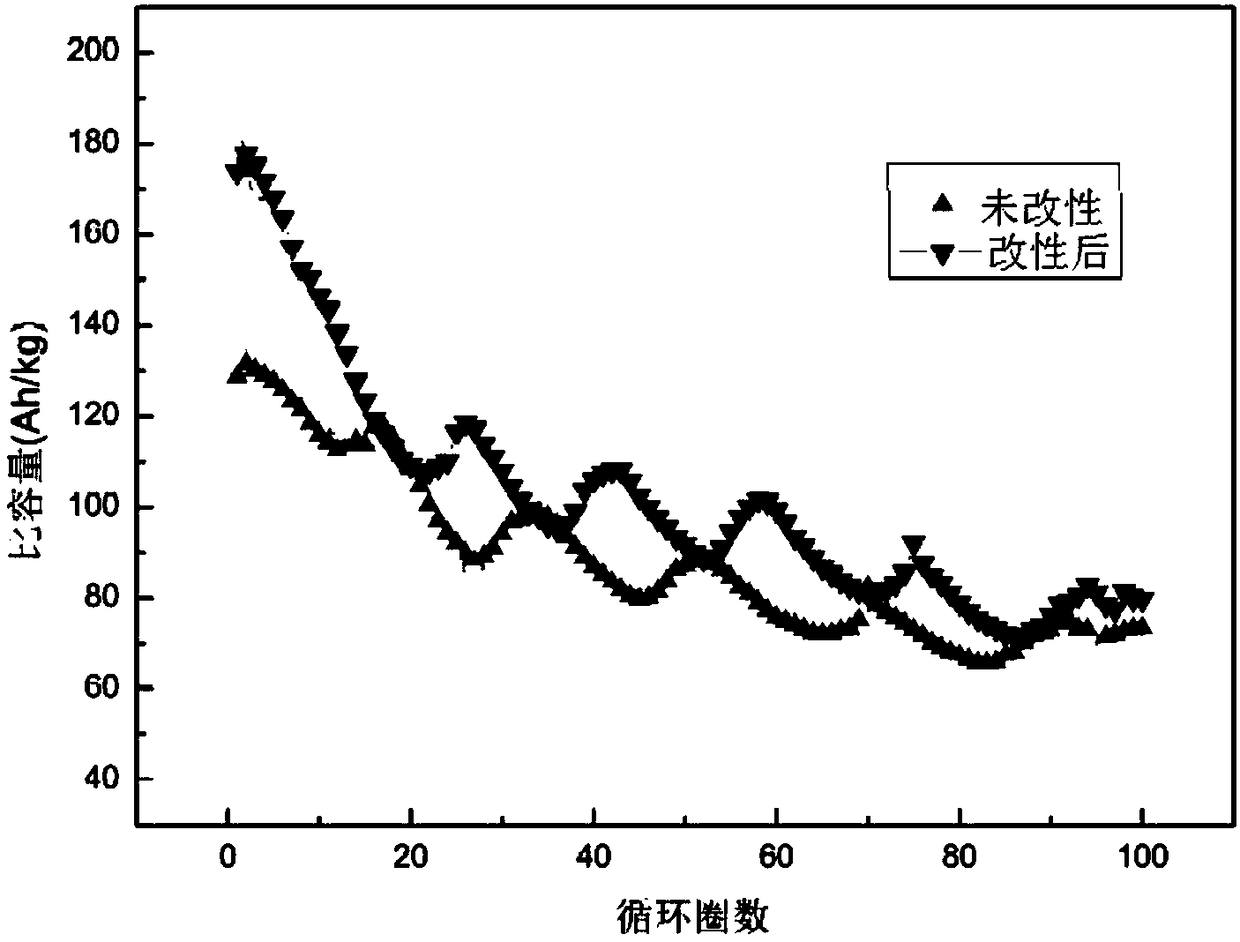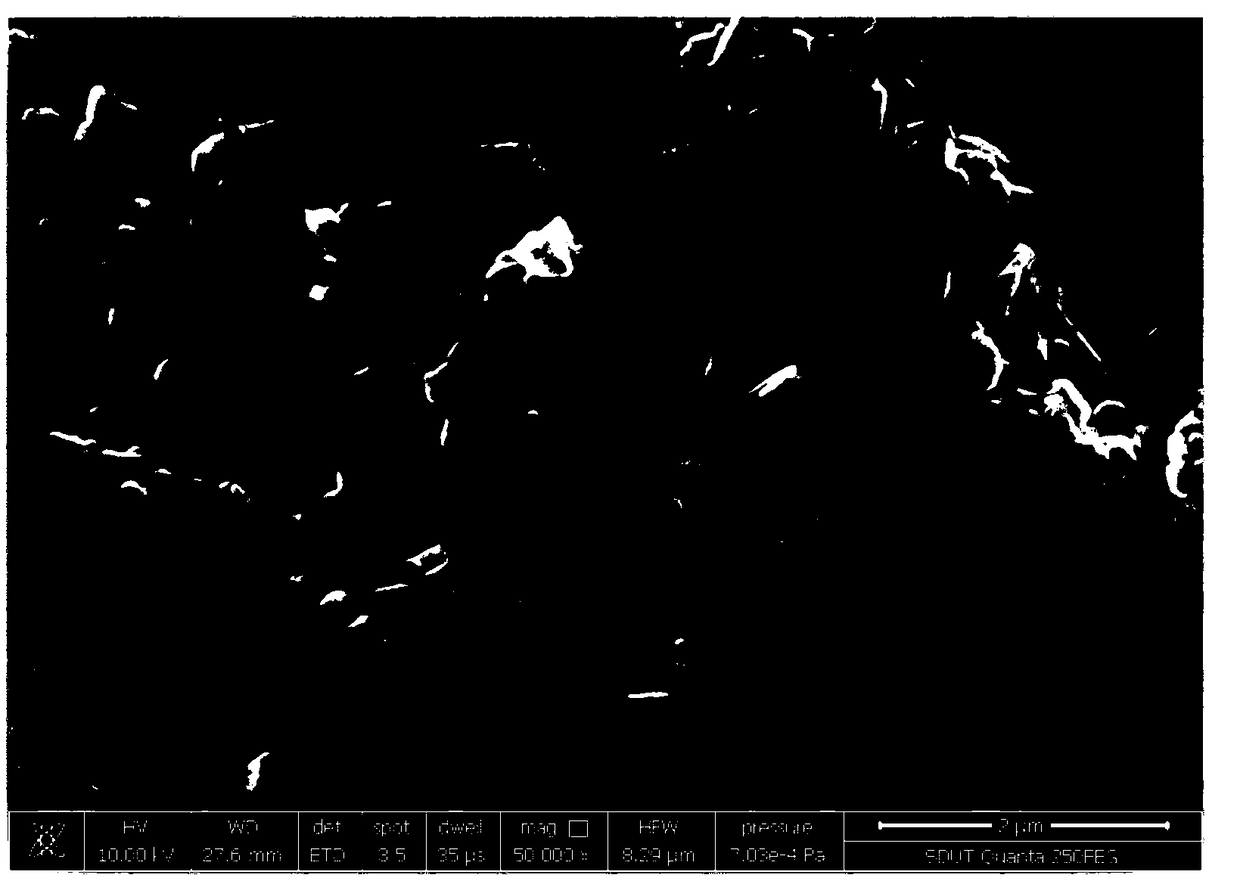Method for preparing lithium aluminate modified ternary anode material based on spent lithium-ion battery cathode materials
A technology for waste lithium batteries and cathode materials, which is applied in the field of preparation of ternary material precursors, can solve problems such as poor stability of ternary cathode materials, and achieve the effects of improving electrochemical performance, good economy and high product quality.
- Summary
- Abstract
- Description
- Claims
- Application Information
AI Technical Summary
Problems solved by technology
Method used
Image
Examples
Embodiment 1
[0047] Disassemble and separate the positive electrode sheet from the waste lithium-ion battery and bake it at 650°C for 15 minutes. The obtained roasted product is crushed on a crusher, sieved, and the positive electrode material is separated from the aluminum foil; the molar ratio of nickel, cobalt, and manganese in the positive electrode material 5:2:3 and 8:1:1;
[0048] The positive electrode material was leached with 2.5 mol / L sodium hydroxide solution at 95°C for 40 minutes, the liquid-solid ratio of the sodium hydroxide solution to the positive electrode material was 10:1 during leaching, and the filtrate and filter cake were obtained by filtration;
[0049] Add sodium carbonate whose molar number is 0.5 times of the lithium ion molar number in the filtrate, stir and react at 25°C for 60min, generate a turbid liquid, filter to obtain lithium carbonate solid and filtrate, and the filtrate is 2.2mol / L sodium hydroxide solution; The recovery rate was 94.6%;
[0050] The ...
Embodiment 2
[0057] Disassemble and separate the positive electrode sheet from the waste lithium-ion battery and roast it at 600°C for 30 minutes. The roasted product obtained is crushed on a crusher, sieved, and the positive electrode material is separated from the aluminum foil; the molar ratio of nickel, cobalt, and manganese in the positive electrode material 6:2:2 and 5:2:3;
[0058] The positive electrode material was leached with 2.0 mol / L potassium hydroxide solution at 75°C for 60 minutes, the liquid-solid ratio of the potassium hydroxide solution to the positive electrode material was 8:1 during leaching, and the filtrate and filter cake were obtained by filtration;
[0059] Add potassium carbonate whose molar number is 0.5 times the lithium ion molar number in the filtrate, stir and react at 40°C for 50min, generate a turbid liquid, filter to obtain lithium carbonate solid and filtrate, and the filtrate is potassium hydroxide solution of 1.7mol / L; The recovery rate is 94.8%;
...
Embodiment 3
[0067] Disassemble and separate the positive electrode sheet from the waste lithium-ion battery and bake it at 500°C for 45 minutes. The obtained roasted product is crushed on a crusher, sieved, and the positive electrode material is separated from the aluminum foil; the molar ratio of nickel, cobalt, and manganese in the positive electrode material 6:2:2 and 4:2:2;
[0068] The positive electrode material was leached with 1.5 mol / L potassium hydroxide solution at 50°C for 100 minutes, the liquid-solid ratio of the potassium hydroxide solution to the positive electrode material was 6:1 during leaching, and the filtrate and filter cake were obtained by filtration;
[0069] Add potassium carbonate whose molar number is 0.5 times the lithium ion molar number in the filtrate, stir and react at 70°C for 30min, generate a cloudy liquid, filter to obtain lithium carbonate solid and filtrate, and the filtrate is potassium hydroxide solution of 1.2mol / L; The recovery rate was 94.4%;
...
PUM
 Login to View More
Login to View More Abstract
Description
Claims
Application Information
 Login to View More
Login to View More - R&D
- Intellectual Property
- Life Sciences
- Materials
- Tech Scout
- Unparalleled Data Quality
- Higher Quality Content
- 60% Fewer Hallucinations
Browse by: Latest US Patents, China's latest patents, Technical Efficacy Thesaurus, Application Domain, Technology Topic, Popular Technical Reports.
© 2025 PatSnap. All rights reserved.Legal|Privacy policy|Modern Slavery Act Transparency Statement|Sitemap|About US| Contact US: help@patsnap.com



